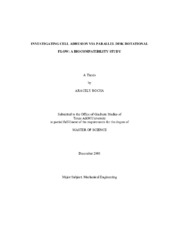| dc.contributor.advisor | Liang, Hong | |
| dc.creator | Rocha, Aracely | |
| dc.date.accessioned | 2011-08-08T22:47:17Z | |
| dc.date.accessioned | 2011-08-09T01:30:00Z | |
| dc.date.available | 2011-08-08T22:47:17Z | |
| dc.date.available | 2011-08-09T01:30:00Z | |
| dc.date.created | 2008-12 | |
| dc.date.issued | 2011-08-08 | |
| dc.date.submitted | December 2008 | |
| dc.identifier.uri | https://hdl.handle.net/1969.1/ETD-TAMU-2008-12-169 | |
| dc.description.abstract | The major impact of this research lies in the aspect of improved design and long
term biocompatibility of materials used for implants. There are two goals in this
research. The first goal is to develop a methodology to quantitatively measure cell-material
adhesion. The second goal is to obtain fundamental understanding of cell-material
adhesion mechanisms. A rotating parallel disk is used to measure cell adhesion.
The rotational system applies a controlled shear stress to the cultured cells. The shear
stress experienced by the cells varies with radial location, being highest at the edge and
zero at the disk?s center. There is a critical point along the radius where the shear stress
experienced by the cells equals their adhesion strength. The cells outside it are removed
and the cells inside it remain attached to the surface.
NIH 3T3 Swiss mouse fibroblasts and chick retina neuron cells from 6-day
embryos are used in this study. The fibroblasts were cultured on poly(methyl
methacrylate) (PMMA), polycarbonate (PC), and on gold coated poly(vinylidene
fluoride) (Au/PVDF). The critical shear stress for fibroblasts was the lowest for PC with
5.09 dynes/cm2 and highest for PMMA with 21.0 dynes/cm2. This four-fold difference is mainly due to the chemical structure of PMMA which promotes higher cell adhesion
when compared to PC.
Neurons were cultured on poly-D-lysine coated glass to promote cell adhesion.
The critical shear stress of neuron cells varied from 3.94 to 27.8 dynes/cm2 these values
are directly proportional to the applied shear stress. The neuron adhesion plateau at ~27
dynes/cm2 which indicates the maximum adhesion strength of the neuron/poly-D-lysine
coated glass pair.
This thesis contains six chapters. Chapter I describes the importance of cell
adhesion for biocompatibility. Chapter II describes in more detail the goals of this
research and the expected results. Chapter III lists all the materials, equipment, and
methods used in this study. The most significant results are summarized in Chapter IV.
The observations and results obtained are explained in detail in Chapter V and Chapter
VI describes the key outcomes as well as proposes questions for the advancement of this
research. | en |
| dc.format.mimetype | application/pdf | |
| dc.language.iso | en_US | |
| dc.subject | cell adhesion, proteins, biocompatibility | en |
| dc.title | Investigating Cell Adhesion via Parallel Disk Rotational Flow: A Biocompatibility Study | en |
| dc.type | Thesis | en |
| thesis.degree.department | Mechanical Engineering | en |
| thesis.degree.discipline | Mechanical Engineering | en |
| thesis.degree.grantor | Texas A&M University | en |
| thesis.degree.name | Master of Science | en |
| thesis.degree.level | Masters | en |
| dc.contributor.committeeMember | Grunlan, Jaime | |
| dc.contributor.committeeMember | Ounaies, Zoubeida | |
| dc.type.genre | thesis | en |
| dc.type.material | text | en |


